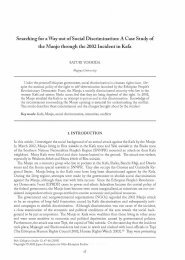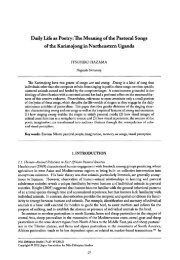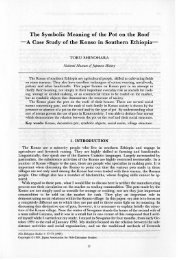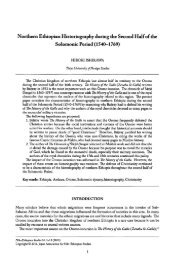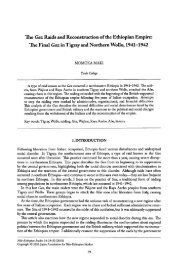Rubbing off the Dirt: Evil-Eye Belief among the Gusii
Rubbing off the Dirt: Evil-Eye Belief among the Gusii
Rubbing off the Dirt: Evil-Eye Belief among the Gusii
Create successful ePaper yourself
Turn your PDF publications into a flip-book with our unique Google optimized e-Paper software.
12 Nilo-Ethiopian Studies<br />
disease. However, I do not have <strong>the</strong> data needed for such a comparative study. When this<br />
kind of belief spreads from one people to ano<strong>the</strong>r, it is not necessarily <strong>the</strong> case that <strong>the</strong><br />
whole set of beliefs will be transmitted. Once <strong>the</strong> idea of <strong>the</strong> evil eye is accepted, <strong>the</strong> people<br />
receiving <strong>the</strong> beliefs may alter <strong>the</strong>m in various ways. This highlights <strong>the</strong> need to collect<br />
more detailed stories about <strong>the</strong> processes involved in <strong>the</strong> introduction of <strong>the</strong> belief.<br />
The statements made by <strong>the</strong> LeVines and Komma seem to point to ano<strong>the</strong>r contradiction.<br />
The former state that it was Kipsigis women who, on becoming wives of <strong>Gusii</strong> men, introduced<br />
<strong>the</strong> evil eye. The latter argues that most Kipsigis evil-eyed people are men. At present<br />
<strong>the</strong>re is no way to determine whe<strong>the</strong>r both statements have some validity or whe<strong>the</strong>r<br />
one is incorrect. Masongo, <strong>the</strong> village in which I lived, is comparatively close to <strong>the</strong> Luo. It<br />
is only an hour's walk from Suneka Market, which is on <strong>the</strong> border between <strong>the</strong> two ethnic<br />
groups. However, village elders say that <strong>the</strong> evil eye did not originate from <strong>the</strong> Luo, but<br />
was brought in from <strong>the</strong> Kipsigis through North Mugirango Location to <strong>the</strong> far north. I do<br />
not have sufficient data to resolve <strong>the</strong>se problems.<br />
Even with this lack of data, it can be seen that <strong>the</strong> form of <strong>the</strong> belief varies <strong>among</strong> <strong>the</strong><br />
<strong>Gusii</strong> and <strong>the</strong> o<strong>the</strong>r ethnic groups in <strong>the</strong> surrounding area in terms of, for example: <strong>the</strong><br />
dominant sex of evil-eyed persons; <strong>the</strong> kind of things which are vulnerable to <strong>the</strong> evil eye;<br />
methods of prevention and treatment; and <strong>the</strong> categorization of <strong>the</strong> evil eye in relation to<br />
witchcraft. Both Wagner <strong>among</strong> <strong>the</strong> Logoli, and Abe <strong>among</strong> <strong>the</strong> Luo interpret an evil-eyed<br />
person as a kind of witch, while Komma distinguishes <strong>the</strong> evil eye from "witchcraft" though<br />
admitting that <strong>the</strong>y are closely related. Among <strong>the</strong> <strong>Gusii</strong>, <strong>the</strong> evil eye and witchcraft are<br />
viewed quite differently, although <strong>the</strong> evil eye is sometimes referred to as a "witchcraft of<br />
eyes," oborogi bw 'amaiso.<br />
The <strong>Gusii</strong> say that <strong>the</strong>re are many contrasting features which distinguish witchcraft and<br />
<strong>the</strong> evil eye. To give a few examples: an evil-eyed person may attack a victim at any time<br />
during <strong>the</strong> day, and <strong>the</strong> effect of <strong>the</strong> evil eye shows itself immediately after <strong>the</strong> attack. A<br />
witch, however, performs vicious acts only at night and <strong>the</strong>se take effect on <strong>the</strong> victim much<br />
later. Witches always operate in a group, but evil-eyed people act alone. Although <strong>the</strong>re are<br />
some notorious witches in most villages, every person is , in <strong>the</strong>ory, vulnerable to <strong>the</strong> accusation<br />
of practicing witchcraft. However, evil-eyed people are usually known as such and<br />
o<strong>the</strong>r people are free from suspicion ofpracticing <strong>the</strong> evil eye. There is a <strong>Gusii</strong> saying: "It is<br />
good to be a witch ra<strong>the</strong>r than a witch of eyes" (Mbuya koba omorogi, kobua koba omorogi<br />
bw 'amaiso) . This saying emphasizes <strong>the</strong> more unfortunate state of being of evil-eyed people<br />
who may victimize anyone nearby at any time, including <strong>the</strong>ir own children. This is in<br />
sharp contrast to witches, who will have a specific reason for attacking people.<br />
Despite <strong>the</strong>se divergences, <strong>the</strong> evil-eye belief in <strong>the</strong>se societies has several significant<br />
features in common:<br />
(1) In some cases, evil-eyed people inherit <strong>the</strong> substance of <strong>the</strong> evil eye. In o<strong>the</strong>rs, <strong>the</strong>y are<br />
regarded as unlucky people who have been given <strong>the</strong> evil eye by someone else. In ei<strong>the</strong>r<br />
case, <strong>the</strong> evil-eyed person is not held personally responsible for any damage caused by<br />
<strong>the</strong>ir evil eye.<br />
(2) Damage caused by <strong>the</strong> evil eye is generally much less serious and infrequent compared<br />
to o<strong>the</strong>r supernatural causes of misfortune. It is considered as a kind of accident that<br />
befalls <strong>the</strong> victim.<br />
(3) <strong>Evil</strong>-eyed people and <strong>the</strong>ir victims are, in most cases, not related in terms of kinship,<br />
residence or socio-economic interest. This is <strong>the</strong> main difference between <strong>the</strong> evil eye<br />
and witchcraft in all <strong>the</strong> societies illustrated above. Cases of transmission of <strong>the</strong> disease<br />
or <strong>the</strong> power of <strong>the</strong> evil eye seldom involve complaints or demands for compensation.<br />
Social anthropologists have paid little attention to <strong>the</strong> evil-eye belief compared to witchcraft<br />
or <strong>the</strong> spirits of <strong>the</strong> dead. In <strong>the</strong> light of points (2) and (3) above, it seems clear that<br />
this lack of interest has stemmed from <strong>the</strong> primacy of o<strong>the</strong>r causes of misfortune in social<br />
life, coupled with an anthropologists' focus on <strong>the</strong> study ofintracommunity ra<strong>the</strong>r than intercommunity<br />
interactions.




